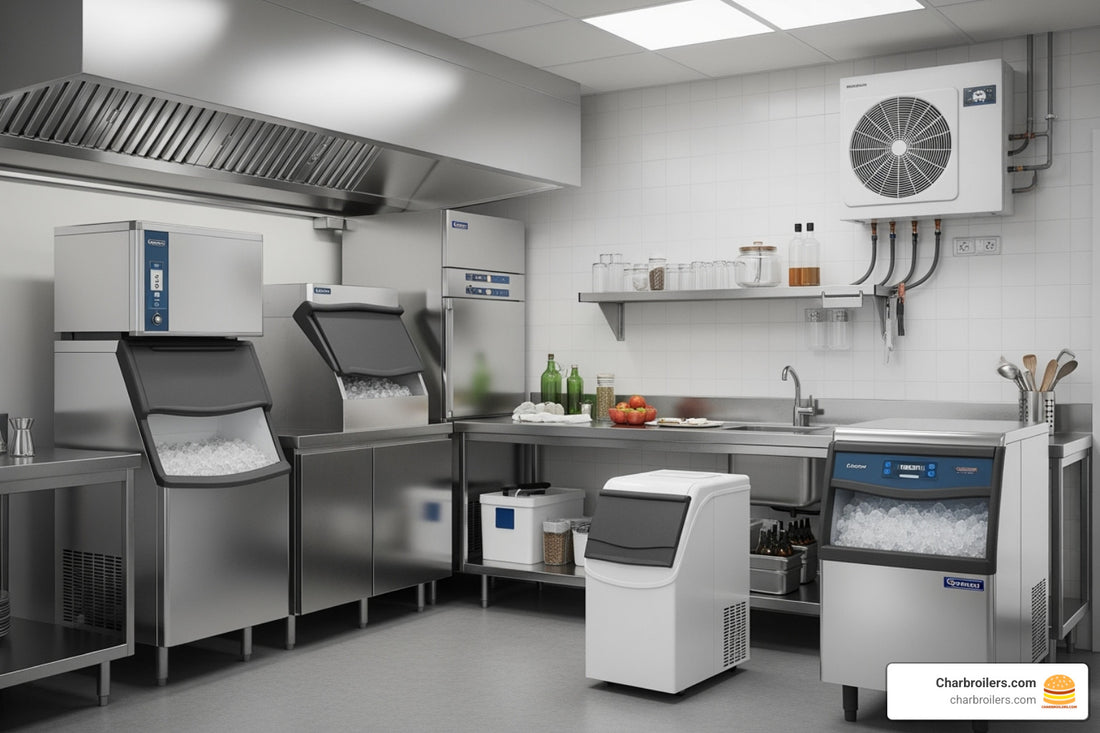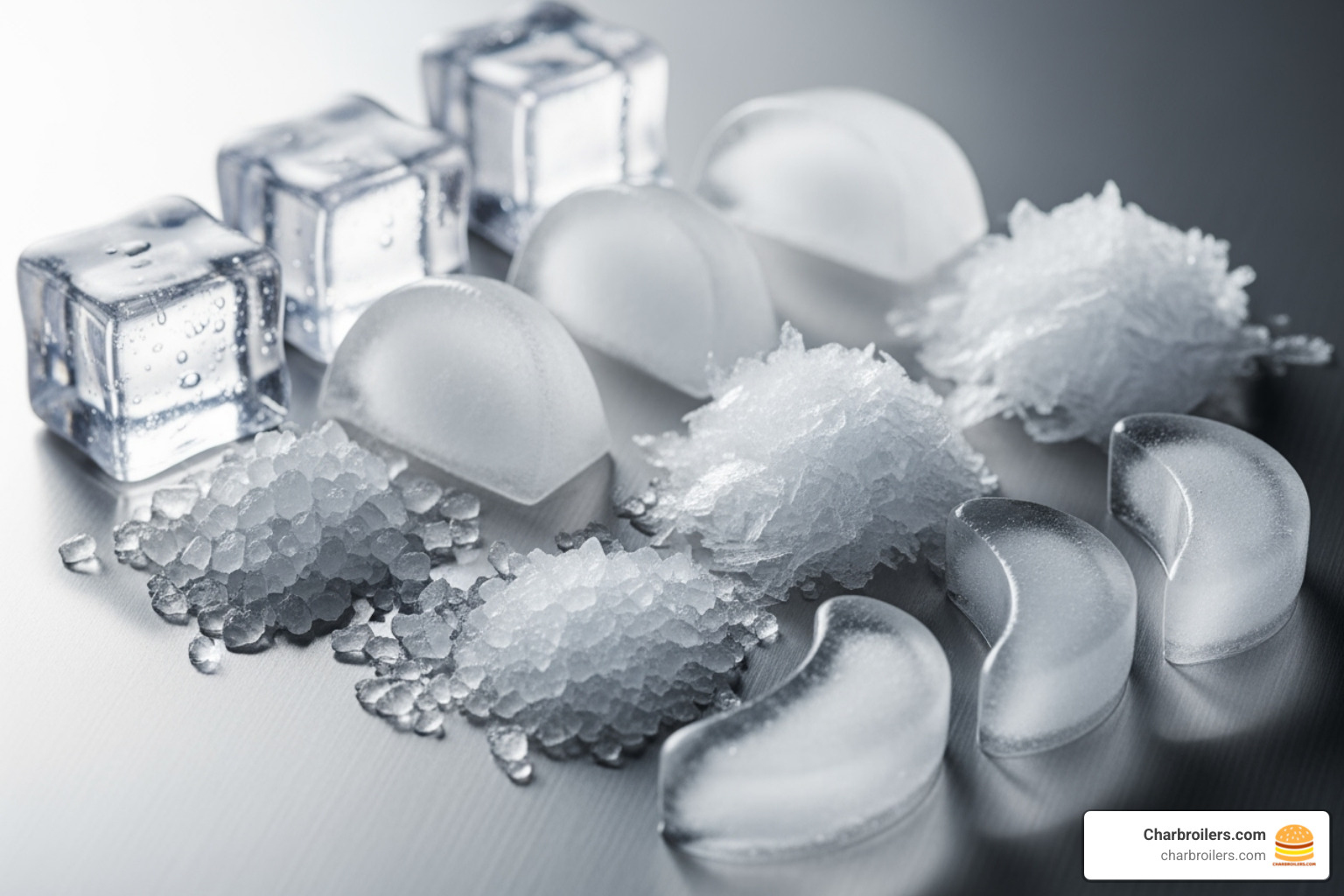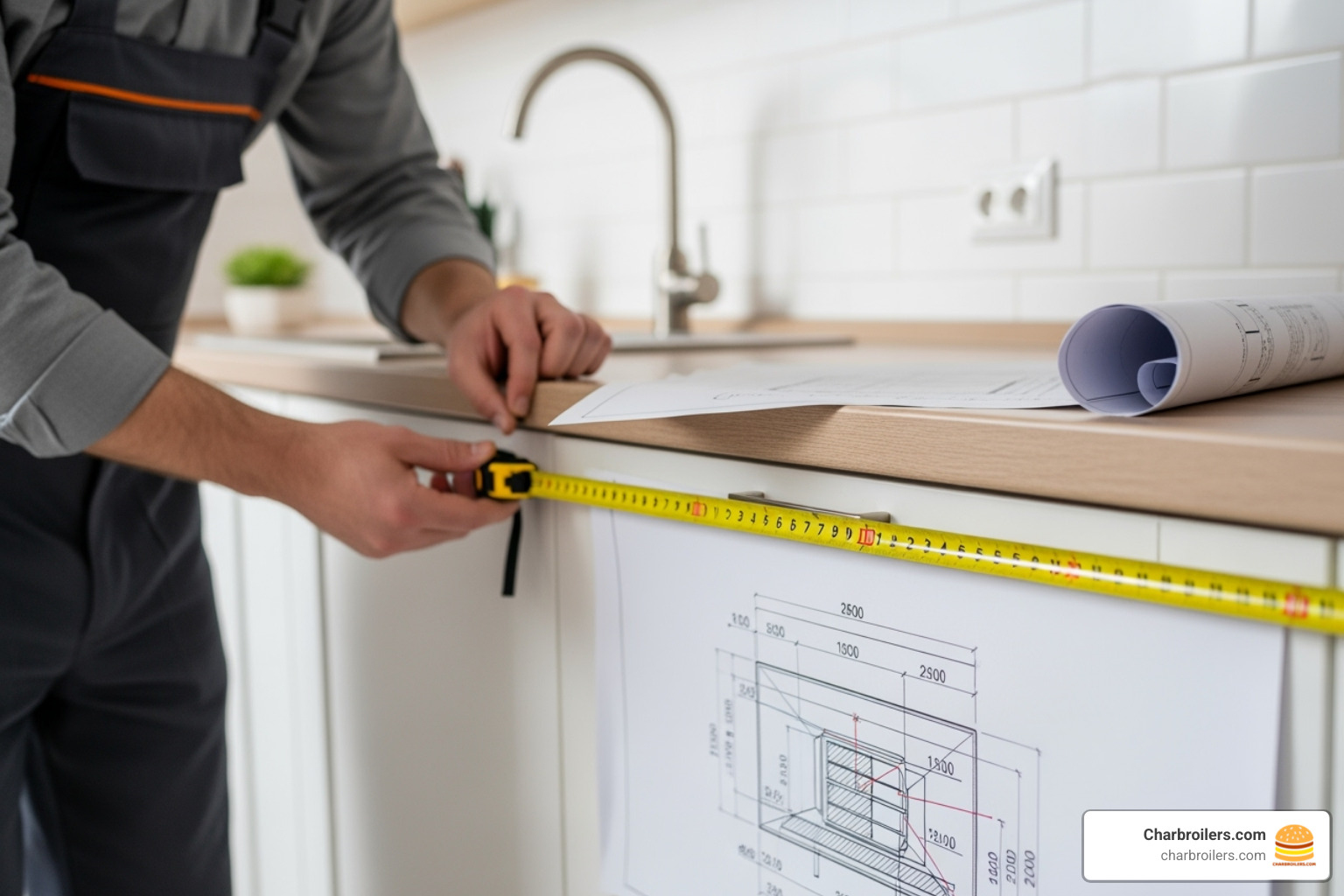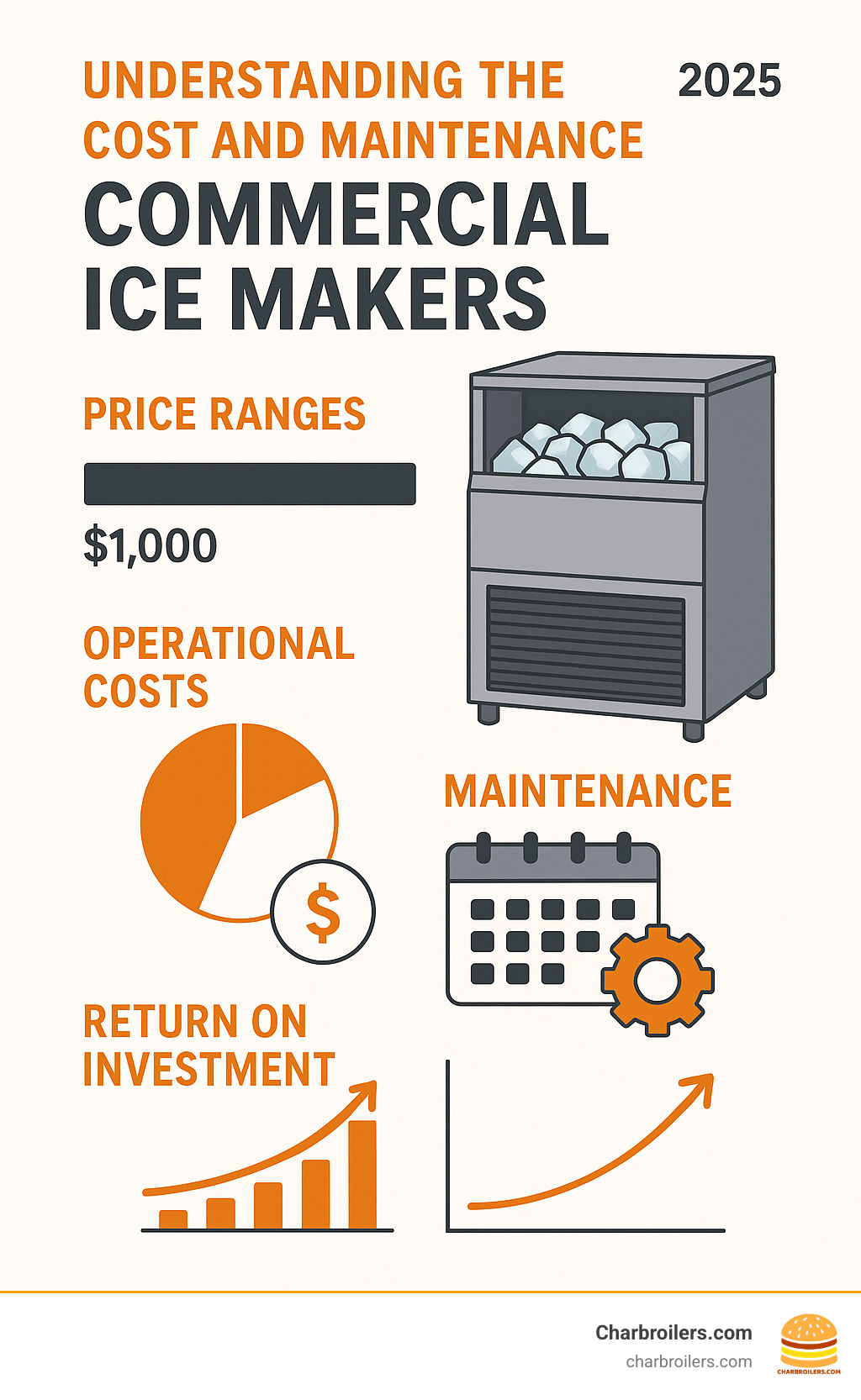
The Ultimate Guide to Comparing Commercial Ice Makers
Share
Why Commercial Ice Makers Are Essential for Your Restaurant Success
Decoding the Types of Commercial Ice Makers
When I walk into a commercial kitchen, I can usually tell within minutes whether they chose the right commercial ice makers for their operation. The difference between a well-matched ice maker and a poor choice is like night and day - one keeps your staff happy and customers satisfied, while the other creates constant headaches.
Your choice comes down to three main factors: how much space you have, how much ice you need, and where you need it. Let's walk through each type so you can find your perfect match.
Modular Ice Machines
Think of modular ice machines as the heavy lifters of the ice world. These powerhouses are built for high-volume production - we're talking 460 lbs to over 1,000 lbs of ice per day. If you're running a busy restaurant or hotel, this is likely your best friend.
The genius of modular systems is right in the name - they're modular. The ice machine head sits separately from the storage bin, giving you incredible flexibility to create a setup that actually works for your space. Got an awkward corner? No problem. Need the ice bin in one spot but the machine head somewhere else? Easy.
I've seen restaurants transform their ice operations by switching to modular setups. One client went from constantly running out of ice during dinner rush to having plenty left over at closing time. The customizable setup meant they could fit a high-capacity system into their cramped kitchen without a complete renovation.
The separate components also make your life easier when it comes to maintenance. You can service the ice machine head without affecting your ice storage, which means less downtime and happier customers.
No Bin, No Problem: Commercial Ice Makers for Modular Setups - This approach is perfect when you need maximum flexibility in your kitchen layout.
Undercounter Ice Makers
If space is tight but you still need serious ice production, undercounter ice makers are your solution. These clever all-in-one designs slide right under a 40-inch counter and typically pump out 100-400 lbs of ice per day with built-in storage up to 100 lbs.
What I love about undercounter units is their simplicity. Everything you need is packed into one neat package - no coordination between separate components, no worrying about matching production to storage capacity. They're the Swiss Army knife of commercial ice makers.
For bars and cafes, these units are particularly brilliant. Your bartenders can grab ice without taking three steps away from their station, which keeps service flowing smoothly even during the busiest Friday night rush. The space-saving design also frees up valuable real estate for other essential equipment.
I've helped countless small kitchen operators find the perfect undercounter solution. One coffee shop owner told me it was like getting an extra employee - always there when needed, never taking up too much space.
Bring the Chill Home: Top Commercial Ice Makers for Residential Use - These units are becoming increasingly popular beyond commercial kitchens too.
Countertop Ice Makers
Countertop ice makers shine in self-service environments where convenience is king. These compact units produce 15-100 lbs of ice per day and are perfect for healthcare facilities, office breakrooms, and quick-service spots.
The real magic happens when these units dispense both nugget ice and water. That soft, chewable nugget ice is a game-changer for smoothies and fountain drinks. In healthcare settings, patients especially appreciate ice that's easy to chew and digest.
Installation couldn't be simpler - most countertop units don't need drain lines, so you can place them anywhere with water and electricity. Some models crank out 36 ice cubes in just 12-15 minutes, which means you're never waiting long for fresh ice.
The compact footprint makes these units incredibly versatile. I've seen them work beautifully in everything from hospital break rooms to hotel lobbies to busy juice bars.
Ice Machines That Mean Business: Hotels, Offices, and Beyond - The applications for these versatile units keep expanding.
Remote Condenser Ice Makers
Remote condenser ice makers solve two problems that plague many commercial kitchens: excess heat and noise. By moving the condenser away from the ice machine, these units keep your kitchen cooler and significantly quieter.
This setup is especially valuable in customer-facing areas where noise control matters. Imagine having your ice machine running quietly near the dining room while the noisy condenser sits outside or in a mechanical room. Your customers get their ice, and you get peace and quiet.
The trade-off is complexity. Remote condenser units require professional installation and careful planning for refrigerant lines. You'll need to coordinate placement of both components and ensure proper ventilation for the remote condenser.
While the upfront installation is more involved, many operators find the benefits worth it. One restaurant owner told me that moving to a remote condenser system dropped their kitchen temperature by several degrees during summer months, making life much more comfortable for the cooking staff.
The Shape of Refreshment: Choosing the Right Ice Type

Here's something many restaurant owners overlook: the shape of your ice can make or break your beverage program. I've seen bartenders struggle with ice that melts too quickly, diluting expensive cocktails, and food service operations lose money because they chose the wrong ice type for their needs.
The ice shape you choose affects melting rate, drink displacement, and texture - three factors that directly impact customer satisfaction. Let me walk you through each type so you can make the best choice for your commercial ice makers.
Full and Half Cube Ice
Full and half cube ice are the reliable workhorses of the beverage world. These slow-melting cubes deliver maximum cooling power while keeping drinks from getting watery too quickly - exactly what you want for cocktails and soft drinks.
Full cubes are perfect for upscale cocktail programs where presentation matters. They melt slowly, keeping that premium whiskey or craft cocktail at the right strength and temperature. Your customers get the full flavor experience they're paying for, not a watered-down disappointment.
Half cubes offer similar benefits but cool drinks faster, making them ideal for quick-service restaurants where speed matters. Both types work great for general beverage service and are excellent if you want to sell bagged ice as an additional revenue stream.
The clear, uniform appearance of cube ice also makes drinks look more appealing - and we all know that customers eat (and drink) with their eyes first.
Nugget Ice
Nugget ice has become incredibly popular, and for good reason. This soft, chewable ice absorbs beverage flavors and creates a unique texture that many customers actually prefer over traditional cubes.
The magic of nugget ice lies in how it blends with beverages. It's particularly fantastic in smoothies, frozen drinks, and fountain sodas where the ice becomes part of the drink experience rather than just a cooling agent. Many customers will specifically seek out businesses that serve nugget ice.
Healthcare facilities often choose nugget ice because it's easier for patients to chew and swallow safely. The soft texture makes it much safer for elderly patients or those with dental issues, while still providing all the cooling benefits they need.
Flake Ice
Flake ice is the champion when you need rapid cooling and food presentation. This soft, moldable ice conforms to any shape, making it absolutely perfect for seafood displays, produce shipping, and salad bars.
The rapid cooling properties of flake ice make it essential for food safety applications. It quickly brings temperatures down and maintains cold chains during food transport. Since it's moldable, it can pack around products of any shape, ensuring even cooling throughout.
If you're running a raw bar or seafood display, flake ice is practically mandatory. It creates an attractive bed for oysters, shrimp, and other seafood while maintaining proper temperatures throughout your entire service period.
Crescent and Specialty Ice
Crescent ice and other specialty shapes offer unique benefits for specific applications. Crescent ice is cleverly designed to prevent splashing in drinks while providing the same slow-melting properties as full cubes.
The curved shape allows crescent ice to nest together efficiently, reducing air gaps and improving cooling efficiency. This makes it particularly good for general beverage service where you want consistent cooling without paying premium prices.
Specialty ice shapes can also provide a high-end aesthetic for upscale establishments. The unique appearance can become part of your brand identity and improve the overall customer experience - sometimes it's the little details that keep customers coming back.
Key Factors to Consider Before You Buy

Choosing a commercial ice maker is like choosing a new chef—you want the right fit, not the biggest résumé. Focus on the essentials below and you’ll avoid overspending or, worse, running out of ice when you’re slammed.
1. Production vs. Storage
- Daily production: Small cafés/office breakrooms need under 100 lbs; most restaurants hit the sweet spot at 100–500 lbs; banquet facilities or hotels can top 1,000 lbs.
- Storage buffer: Keep a bin that holds ≈ 40–50 % of daily production so you’re covered during lunch rush or happy hour.
- Quick rule: Restaurants need ≈ 1.5 lbs per meal, bars ≈ 3 lbs per guest.
For a deeper dive into pairing heads and bins, see Cool Choices for Commercial Ice Maker and Bin Setups.
2. Condenser Style
- Air-cooled: Most common, no water waste, but efficiency drops in hot kitchens.
- Water-cooled: Keeps output steady in high ambient temps; watch your water bill.
- Remote-cooled: Puts heat and noise outside. Higher install cost but friendlier kitchen climate.
3. Installation Basics
- Clearances: Air-cooled units usually need 6 in. side / 12 in. top airflow.
- Utilities: Confirm water supply, drain location, and the correct 115 V or 230 V circuit before the unit arrives.
- Water quality: A simple filter prevents scale, bad taste, and warranty headaches.
4. Features Worth Paying For
- Self-cleaning cycles save labor and improve food safety.
- ENERGY STAR® ratings cut utility costs year-after-year.
- ADA-compliant dispensers ensure customer access where required.
- All-stainless bodies withstand heavy commercial abuse.
A few minutes with a tape measure and last month’s sales report will tell you almost everything you need to know—then pick the model that fits your numbers, not just your wishlist.
Understanding the Cost and Maintenance of Commercial Ice Makers

The sticker price is just the opening act. Smart operators look at total cost of ownership—purchase, utilities, and upkeep over a 7- to 10-year life span. (If you’re curious about how these machines actually freeze water, the background on ice machines is a quick read.)
What Will You Spend Upfront?
- Entry units (< 100 lbs/day) run $1,000–$2,000.
- Mid-range (200–500 lbs/day) cost $2,500–$4,000.
- High-volume workhorses (> 500 lbs/day) land around $4,000–$6,500+.
Price rises with capacity, modular flexibility, remote condensers, and premium features like ENERGY STAR® or self-cleaning programs. Remember: a slightly larger machine usually drops the cost per pound of ice.
Operating Costs to Watch
- Electricity vs. water: Air-cooled means higher kWh, water-cooled means higher gallons—compare local rates.
- Service calls: Preventive maintenance is cheaper than emergency repairs during Saturday dinner.
Cleaning & Maintenance—in 3 Bullet Points
- Schedule: Clean and sanitize every 3–6 months minimum; monthly for hard-water or high-volume sites.
- Process: Shut down, drain, apply manufacturer’s cleaner, scrub, rinse well, and toss the first ice batch.
- Filters: Replace when flow slows or at least twice a year—cheap insurance against scale and off-flavors.
Warning Signs You Can’t Ignore
- Production drop or tiny cubes → probable scale buildup.
- Cloudy ice or odd tastes → clean ASAP; ice is an FDA-regulated food.
- New noises → call a tech before small issues become compressor failures.
Stay on top of these basics and your ice maker will quietly keep guests refreshed—and your profits solid—for years.
Frequently Asked Questions about Commercial Ice Makers
Running a successful food service operation means having reliable ice on demand, but questions about commercial ice makers often arise when you're making this important investment. Let me address the most common concerns I hear from restaurant owners and operators.
How often should I clean my commercial ice machine?
Your commercial ice maker needs cleaning a minimum of 2-4 times per year - that's every 3-6 months at the very least. Think of it like changing the oil in your car - regular maintenance prevents bigger problems down the road.
However, your specific situation might demand more frequent attention. If your local water is particularly hard or mineral-rich, you'll need to clean more often. High-volume operations that run their machines constantly may need monthly cleaning to maintain quality.
Your kitchen environment also plays a role. Dusty conditions or greasy air from cooking can accelerate contamination, while hot kitchens create ideal conditions for bacterial growth. Pay attention to your ice quality - if you notice smaller cubes, cloudiness, or any off-flavors, clean immediately regardless of your schedule.
The key is staying ahead of problems rather than reacting to them. Clean ice isn't just about taste - it's about food safety and protecting your customers.
How do I know what size ice maker I need?
Sizing your ice maker correctly is crucial for avoiding the frustration of running out during your busiest periods. The calculation depends on your business type and peak demand patterns.
Restaurants should plan for approximately 1.5 lbs of ice per meal served during peak hours. If you serve 200 meals during your dinner rush, you'll need about 300 lbs of ice production capacity. Bars have much higher requirements - about 3 lbs per customer due to cocktail consumption and the need to keep drinks properly chilled.
Hotels need to calculate based on occupancy rates and guest amenities, while healthcare facilities must consider patient needs and dietary requirements. Don't forget about storage capacity either - you need enough storage to handle peak periods when consumption exceeds production.
A good rule of thumb is storage capacity equal to 40-50% of daily production. This buffer ensures you won't run out during unexpected rushes or if your machine needs brief maintenance.
Consider your growth plans too. It's much better to slightly oversize your equipment than to outgrow it within a year and face another major purchase.
Why is my ice maker making small or cloudy ice?
Small or cloudy ice is your machine's way of telling you it needs attention - and it's usually a sign that cleaning is overdue. This is one of the most common issues I see, and fortunately, it's often easy to fix.
Mineral buildup on the evaporator is the most frequent culprit. As water evaporates and freezes repeatedly, minerals accumulate and interfere with proper ice formation. A clogged water filter can also restrict water flow and quality, leading to incomplete ice cubes.
Sometimes the issue is incorrect water level due to scale buildup or sensor problems. When the machine can't maintain proper water levels, ice formation suffers. Bacterial contamination can also cause cloudiness and create unpleasant flavors that affect your beverages.
Address this issue immediately by thoroughly cleaning the machine and replacing water filters. The cleaning process involves descaling and sanitizing all internal components - don't skip any steps. If problems persist after a complete cleaning, contact a service technician to check for mechanical issues.
Clear ice isn't just about appearance - it's about providing your customers with the quality they expect and deserve.
Conclusion
Choosing the right commercial ice maker isn't just about picking the cheapest option or the one with the most features. It's about finding the perfect match for your unique operation - one that keeps your customers happy and your business running smoothly.
Think of your ice maker as a silent partner in your success. When it's working properly, nobody notices it. But when it fails during your busiest Saturday night rush, everyone feels the impact. That's why getting this decision right matters so much.
The type of ice maker you choose sets the foundation. A busy restaurant needs the high-volume reliability of a modular system, while an intimate cocktail bar thrives with the space-saving convenience of an undercounter unit. The ice shape you select affects everything from how quickly drinks cool to how long they stay cold without diluting.
Capacity planning requires honest assessment of your peak demands. It's better to have slightly more capacity than you think you need rather than scrambling to keep up during busy periods. Restaurants typically need about 1.5 lbs of ice per meal served, while bars require around 3 lbs per customer.
Don't let the initial price tag be your only consideration. An ENERGY STAR® certified unit might cost more upfront, but those energy savings add up month after month. The same goes for features like self-cleaning cycles - they reduce labor costs and ensure consistent ice quality over time.
Maintenance isn't optional - it's essential for food safety and equipment longevity. Since the FDA treats ice as a food product, proper cleaning every 3-6 months protects both your customers and your investment. Regular maintenance also prevents those costly emergency repairs that always seem to happen at the worst possible moment.
The right commercial ice maker becomes an invisible but crucial part of your operation. Your customers will never compliment you on having perfectly clear, properly sized ice cubes, but they'll definitely notice if their drinks are warm or taste off.
At Charbroilers.com, we understand that every piece of equipment in your kitchen needs to work together seamlessly. Your ice maker is just one part of creating exceptional dining experiences that keep customers coming back.
Find the perfect equipment for your restaurant and build the foundation for long-term success in the competitive food service industry. After all, great food deserves great equipment - and that includes the ice that keeps everything perfectly chilled.
